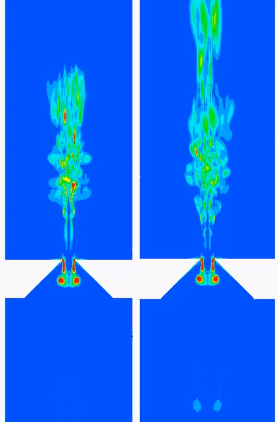Noise suppression technology for aircraft jet engines
JAXA Supercomputer System Annual Report April 2017-March 2018
Report Number: R17EA0716
Subject Category: Aeronautical Technology
- Responsible Representative: Toshiya Nakamura(Aeronautical Technology Directorate, Next Generation Aeronautical Innovation Hub Center)
- Contact Information: Shunji ENOMOTO enomoto.shunji@jaxa.jp
- Members: Shunji ENOMOTO, Tatsuya ISHII, Kae ITO, Nobuhiko YAMASAKI
Abstract
Noise generated from the jet engine is dominant to total aircraft noise level and it is very important to reduce this. In this project, demonstration of exhaust noise reduction by changing exhaust duct shape, and study of noise reduction technique by numerical analysis are carried out.
Reference URL
Please refer to ‘Green engine technology | ECAT – Environment-Conscious Aircraft Technology Program | Aeronautical Technology Directorate‘.
Reasons for using JSS2
The calculation was LES with a large amount of computation and storage usage. It was necessary to use SORA-PP and SORA-FS.
Achievements of the Year
In order to investigate the behavior when sound waves pass through a jet, LES calculation of a jet was performed using UPACS-LES, and sound waves were injected from the side of the jet. The temperature distribution is shown in Fig. 1. Jet’s Mach number is 0.8. Figure 2 shows the sound pressure. It turned out that the sound reflected, refracted, and diffused by the jet. Also 3-D flow field around the aperture of the acoustic liner was simulated to study the mechanism of the improvement of sound absorbing performance when the bias flow presents for the aperture. Figure 3 shows the vorticity contour near the tapered aperture and we can observe that the distribution of the turbulent vortices, which is considered to be the dissipation source, is wider in space in the bias flow case.
Fig.1(video): Temperature
Fig.2(video): Sound pressure
Publications
N/A
Usage of JSS2
Computational Information
- Process Parallelization Methods: MPI
- Thread Parallelization Methods: N/A
- Number of Processes: 12 – 36
- Elapsed Time per Case: 39.00 hours
Resources Used
Fraction of Usage in Total Resources*1(%): 0.18
Details
Please refer to System Configuration of JSS2 for the system configuration and major specifications of JSS2.
| System Name | Amount of Core Time(core x hours) | Fraction of Usage*2(%) |
|---|---|---|
| SORA-MA | 0.45 | 0.00 |
| SORA-PP | 252,793.70 | 3.17 |
| SORA-LM | 0.00 | 0.00 |
| SORA-TPP | 8,282.24 | 0.92 |
| File System Name | Storage Assigned(GiB) | Fraction of Usage*2(%) |
|---|---|---|
| /home | 022.12 | 0.02 |
| /data | 2,213.67 | 0.04 |
| /ltmp | 2,678.57 | 0.20 |
| Archiver Name | Storage Used(TiB) | Fraction of Usage*2(%) |
|---|---|---|
| J-SPACE | 11.28 | 0.49 |
*1: Fraction of Usage in Total Resources: Weighted average of three resource types (Computing, File System, and Archiver).
*2: Fraction of Usage:Percentage of usage relative to each resource used in one year.
JAXA Supercomputer System Annual Report April 2017-March 2018



